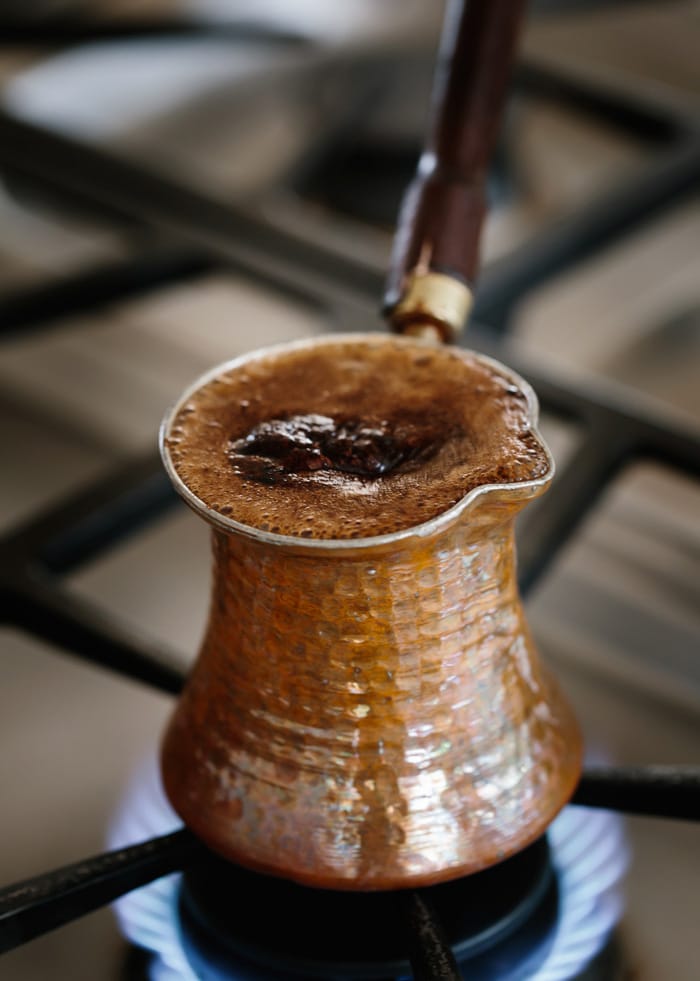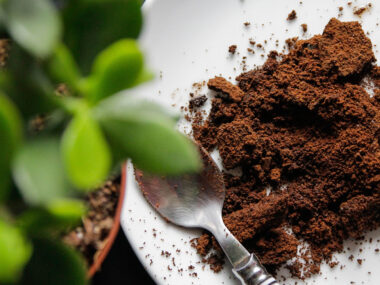Learning how to make Turkish coffee lets you enjoy a rich, aromatic drink that’s full of tradition and flavor in every cup.
Turkish coffee isn’t just a beverage; it’s an experience. Crafted with care, it has a unique preparation method that sets it apart from other coffees. This ancient technique involves finely ground coffee beans, water, and sugar, brewed to perfection in a special pot called a cezve.
The result is a strong, flavorful coffee with a delightful foam on top. Whether you’re a coffee enthusiast or a curious beginner, learning to make Turkish coffee can be both fun and rewarding. Dive into this guide to discover the steps needed to brew your own cup of this timeless coffee. Get ready to enjoy a taste of tradition and culture in every sip!
Ingredients Needed
Making Turkish coffee is a delightful experience that requires a few specific ingredients. This section will guide you through the essential components needed for brewing the perfect cup of Turkish coffee. Let’s dive into the details of each ingredient.
Coffee Beans
Turkish coffee is unique because of its finely ground coffee beans. The beans should be very fresh and ground to a powdery texture. Here’s what you need to know:
- Type of Beans: Arabica beans are preferred for their rich flavor and smooth taste.
- Grinding: The beans must be ground to a very fine powder, almost like flour. This consistency is essential for the coffee’s texture.
- Freshness: Freshly ground beans produce the best flavor. Use the beans within a week of grinding for optimal taste.
It’s best to use a coffee grinder specifically designed for Turkish coffee. This ensures the beans are ground to the right consistency. If you don’t have a grinder, you can buy pre-ground Turkish coffee from a reliable source.
Water
Water is a crucial ingredient for Turkish coffee. The quality and temperature of the water can affect the taste. Here are some tips:
- Quality: Use fresh, cold water. Filtered or bottled water is ideal to avoid any impurities that might affect the flavor.
- Measurement: Typically, you’ll need one demitasse cup of water per serving. A demitasse cup holds about 3 ounces (90 ml) of water.
- Temperature: Start with cold water. This allows the coffee to heat slowly and develop its full flavor during brewing.
Using the right amount of water is essential for the perfect balance. Too much water can dilute the flavor, while too little can make the coffee overly strong.
Sugar
Sugar in Turkish coffee is optional but traditional. It’s usually added during the brewing process. Here’s how to use it:
- Types of Sugar: Granulated sugar is commonly used. Avoid using powdered or brown sugar.
- Amount: The amount of sugar varies based on taste. Here are the common measurements:
- No sugar: “Sade”
- Little sugar: “Az şekerli” (half a teaspoon)
- Medium sugar: “Orta şekerli” (one teaspoon)
- Sweet: “Şekerli” (one and a half to two teaspoons)
Mix the sugar with water and coffee before brewing. This ensures the sugar dissolves well and blends with the coffee. It’s important to stir the mixture before heating to distribute the sugar evenly.

Credit: foolproofliving.com
Grinding The Coffee
Turkish coffee is a rich and aromatic way to enjoy your daily caffeine fix. The process of making Turkish coffee is an art, and one of the most critical steps is grinding the coffee. Grinding the coffee beans to the right consistency is essential for achieving the perfect flavor and texture. Let’s dive into the details of how to grind your coffee beans for Turkish coffee.
Choosing The Right Grind
For Turkish coffee, the grind size is incredibly important. The coffee needs to be ground to a fine powder, almost like flour. This fine grind allows for the coffee to dissolve completely in water, creating a smooth, rich cup.
Here are a few key points to consider when choosing the right grind:
- Finest Grind: The grind should be finer than espresso. It should feel like powdered sugar between your fingers.
- Consistency: The grind should be even and consistent. Uneven grinds can affect the taste and texture of the coffee.
- Freshness: Always grind your coffee beans just before brewing. Freshly ground coffee retains more aroma and flavor.
Here’s a quick comparison of grind sizes for different types of coffee:
| Type of Coffee | Grind Size |
|---|---|
| French Press | Coarse |
| Drip Coffee | Medium |
| Espresso | Fine |
| Turkish Coffee | Extra Fine |
By selecting the right grind, you ensure that your Turkish coffee will have the rich, smooth taste that it’s known for.
Tools For Grinding
To achieve the perfect grind, you need the right tools. Here are some of the best tools for grinding coffee beans for Turkish coffee:
- Manual Coffee Grinder: A traditional manual coffee grinder is often preferred for Turkish coffee. These grinders allow for precise control over the grind size.
- Electric Coffee Grinder: An electric grinder can also be used, but it must be capable of producing an extra fine grind. Look for grinders with adjustable settings.
- Mortar and Pestle: In a pinch, a mortar and pestle can be used to grind coffee beans. This method requires more effort but can produce a fine grind.
When using a manual coffee grinder:
- Set the grinder to the finest setting.
- Place a small amount of coffee beans in the grinder.
- Turn the handle in a consistent, steady motion.
- Check the grind size periodically to ensure consistency.
For electric grinders, follow these steps:
- Adjust the grinder to the finest setting.
- Measure the desired amount of coffee beans.
- Grind the beans in short bursts to prevent overheating.
- Check the grind size and adjust if necessary.
Properly ground coffee beans are the foundation of a perfect cup of Turkish coffee. Choose your tools wisely and pay attention to the grind size for the best results.
Preparing The Pot
Making Turkish coffee is an art form that requires precision and care. One crucial step in this process is preparing the pot, known as a cezve. The cezve plays a vital role in achieving the rich, bold flavor that Turkish coffee is famous for. Let’s dive into the details of selecting and cleaning the cezve to ensure that your coffee-making experience is flawless.
Selecting A Cezve
Choosing the right cezve is essential for making authentic Turkish coffee. A cezve is a small pot, typically made of copper or brass, with a long handle. Here are some tips to help you select the perfect one:
- Material: Copper cezves are highly recommended because they conduct heat evenly. Brass is also a good choice, but copper is preferred for its durability.
- Size: Cezves come in various sizes. Choose one that suits the number of servings you usually prepare. A small cezve is ideal for one or two cups, while a larger one can accommodate more.
- Handle: Look for a cezve with a long, sturdy handle. This makes it easier to hold and pour the coffee without burning your hand.
- Shape: The shape of the cezve should be narrow at the top and wider at the bottom. This design helps to create the perfect foam on top of the coffee.
Here is a quick comparison table to help you decide:
| Material | Pros | Cons |
|---|---|---|
| Copper | Even heat distribution, durable | Requires regular polishing |
| Brass | Good heat conduction, sturdy | Can tarnish over time |
By choosing the right cezve, you ensure that your Turkish coffee will have the perfect taste and texture.
Cleaning The Cezve
Proper cleaning of the cezve is crucial to maintain its quality and longevity. After each use, follow these steps:
- Rinse Immediately: As soon as you finish making coffee, rinse the cezve with warm water. This prevents coffee residue from sticking to the pot.
- Use Mild Detergent: If there are stubborn stains, use a mild detergent. Avoid harsh chemicals as they can damage the cezve’s material.
- Scrub Gently: Use a soft sponge or cloth to scrub the cezve. Avoid abrasive pads that can scratch the surface.
- Dry Thoroughly: After washing, dry the cezve completely with a clean towel. Moisture can lead to tarnishing, especially in copper cezves.
- Polish Regularly: For copper cezves, regular polishing is necessary to keep them shiny. Use a copper polish or a mixture of lemon juice and salt.
Here are some tips to keep in mind:
- Never use a dishwasher for cleaning the cezve.
- Avoid soaking the cezve in water for long periods.
- Store the cezve in a dry place to prevent moisture damage.
Proper cleaning ensures that your cezve remains in excellent condition, providing you with delicious Turkish coffee every time.

Credit: www.homegrounds.co
Brewing Process
Making Turkish coffee is an art. The brewing process is simple yet precise. Each step contributes to the rich, aromatic flavor that defines this traditional drink. From mixing ingredients to heating the cezve, every detail matters.
Mixing Ingredients
Start with fresh, cold water. Measure one cup of water for each cup of coffee you plan to make. Pour the water into the cezve, a small, long-handled pot used specifically for Turkish coffee.
Add finely ground coffee to the water. Use a heaping teaspoon for each cup. The coffee should be ground to a powder-like consistency. This ensures a smooth texture.
Next, add sugar if desired. Turkish coffee can be prepared with varying levels of sweetness:
- No sugar – “Sade”
- Low sugar – “Az şekerli” (half a teaspoon)
- Medium sugar – “Orta şekerli” (one teaspoon)
- High sugar – “Şekerli” (one and a half to two teaspoons)
Stir the mixture gently to combine the ingredients. Avoid vigorous stirring to prevent dissolving the coffee grounds. The goal is to blend them evenly without agitation.
Heating The Cezve
Place the cezve on the stove over low heat. The slow heating process is crucial for developing the coffee’s full flavor. Watch the coffee closely as it warms.
As the coffee heats, a dark foam will form on the surface. This foam is a signature feature of Turkish coffee. Use a spoon to gently transfer some of the foam into each coffee cup. This step ensures that every cup has a rich, creamy top layer.
Continue to heat the coffee until it reaches the boiling point. Be careful not to let it boil over. As soon as it starts to rise, remove the cezve from the heat. Let it settle for a few seconds, then return it to the heat. Repeat this process two to three times. This helps to build up the foam and deepen the flavor.
Pour the coffee into the cups, allowing the grounds to settle at the bottom. Turkish coffee is traditionally served in small cups without filters. This means the grounds will remain in the cup, adding to the experience.
Enjoy your Turkish coffee slowly. Savor the rich, complex flavors and the unique texture. The brewing process, though simple, creates a drink that is both robust and refined.
Foam Formation
Creating the perfect Turkish coffee involves a few key steps, and one of the most critical aspects is foam formation. Foam, or “köpük” in Turkish, is the frothy layer that forms on top of the coffee. It adds a creamy texture and enhances the coffee’s aroma. Achieving the right foam can be a bit tricky, but understanding its importance and learning the proper techniques can help you make a delicious cup of Turkish coffee.
Importance Of Foam
Foam is not just a visual element; it plays a significant role in the overall experience of Turkish coffee. Here are some reasons why foam is important:
- Aesthetic Appeal: Foam gives Turkish coffee its distinctive look, making it more inviting.
- Texture: It adds a creamy, smooth texture to the coffee, making each sip enjoyable.
- Aroma: The foam helps to trap the coffee’s aroma, enhancing the sensory experience.
- Tradition: Foam is a hallmark of well-made Turkish coffee, reflecting the skill and care of the person preparing it.
Foam formation is a sign of a well-prepared Turkish coffee. It shows that the coffee was brewed with the right temperature and technique. Without foam, Turkish coffee can taste flat and lack the depth that makes it special.
Techniques For Foam
Creating the perfect foam requires attention to detail and practice. Here are some techniques to help you achieve a rich, frothy foam:
- Use Fresh Coffee: Freshly ground coffee beans produce better foam. Stale coffee can result in a weak or no foam.
- Correct Water Temperature: Use cold water when starting. This ensures a slow heating process, crucial for foam formation.
- Gentle Stirring: Stir the coffee and water gently to mix them. Avoid vigorous stirring, which can break the foam.
- Heat Control: Brew the coffee over low heat. High heat can cause the coffee to boil quickly, which prevents foam formation.
- Patience: Allow the coffee to slowly rise and form foam. Rushing can lead to incomplete foam formation.
Another technique involves using a special pot called a cezve, designed for making Turkish coffee. The cezve’s shape helps to concentrate the heat and promote foam formation.
Table summarizing key techniques:
| Technique | Description |
|---|---|
| Fresh Coffee | Use freshly ground coffee beans for better foam. |
| Water Temperature | Start with cold water to ensure slow heating. |
| Gentle Stirring | Stir gently to mix coffee and water without breaking foam. |
| Heat Control | Brew over low heat to prevent boiling and ensure foam. |
| Patience | Allow the coffee to rise slowly for complete foam formation. |
By following these techniques, you can master the art of foam formation and enjoy a delicious cup of Turkish coffee.

Credit: kahwati.co.uk
Serving The Coffee
Serving Turkish coffee is an art that completes the experience of enjoying this rich, aromatic beverage. The way you serve it can enhance the flavors and make the moment more memorable. Let’s explore the traditional methods of serving Turkish coffee and how to pair it with delicious snacks.
Traditional Serving Methods
Traditional serving methods of Turkish coffee are steeped in culture and tradition. This begins with the choice of cups. Turkish coffee is typically served in small cups known as “fincans.” These cups are similar to espresso cups but are often more ornate, sometimes made of porcelain or copper.
Key elements of traditional serving:
- Serving tray: A beautifully decorated tray adds to the experience. Copper or silver trays are commonly used.
- Water glass: A small glass of water is served alongside the coffee. This helps cleanse the palate before and after drinking the coffee.
- Turkish delight: A piece of Turkish delight or a small sweet is often placed on the tray. This complements the strong flavor of the coffee.
These elements create a visually appealing and culturally rich experience. The coffee is poured slowly into the fincan, ensuring that the foam (known as “köpük”) remains intact. This foam is a sign of a well-made Turkish coffee.
| Element | Description |
|---|---|
| Fincan | Small, ornate cup |
| Serving Tray | Decorated, often copper or silver |
| Water Glass | Small glass of water to cleanse palate |
| Turkish Delight | Sweet treat to complement coffee |
By following these traditional methods, you honor the rich history and cultural significance of Turkish coffee.
Pairing With Snacks
Pairing Turkish coffee with the right snacks can elevate the experience. The strong, bold flavor of the coffee pairs well with a variety of sweet and savory treats.
Popular snack pairings:
- Baklava: The sweetness and layers of this pastry balance the bitterness of the coffee.
- Turkish Delight: Often served alongside the coffee, its chewy texture and sweetness complement the drink perfectly.
- Chocolate: Dark chocolate, in particular, pairs well with Turkish coffee due to its rich, intense flavor.
- Nuts: A small bowl of mixed nuts provides a savory counterpoint to the coffee’s bold taste.
These snacks not only complement the coffee but also enhance the overall experience. The combination of flavors creates a delightful contrast, making each sip and bite more enjoyable.
In summary, serving Turkish coffee with traditional methods and pairing it with the right snacks can turn a simple coffee break into a special occasion. Whether you are sharing this moment with friends or enjoying it alone, these tips will help you appreciate the unique qualities of Turkish coffee.
Cultural Significance
Turkish coffee is more than just a drink; it’s a cultural experience. The tradition of making and enjoying Turkish coffee holds deep cultural significance. This age-old practice embodies hospitality, socialization, and a connection to the past. Let’s explore its rich history and how it is enjoyed today.
Historical Context
Turkish coffee has a long history dating back to the Ottoman Empire. This unique coffee preparation method began in the mid-16th century. It quickly spread across the empire and into Europe. The process involves finely ground coffee beans, water, and sugar, all brewed together in a special pot called a cezve.
Key historical points include:
- The first coffeehouse in Istanbul opened in 1555.
- Coffee became a symbol of sophistication and intellect.
- Sultans and nobles often enjoyed Turkish coffee during important meetings.
Here is a brief timeline:
| Year | Event |
|---|---|
| 1555 | First coffeehouse opens in Istanbul. |
| 17th century | Turkish coffee spreads to Europe. |
| 19th century | Becomes a staple in social and political gatherings. |
Turkish coffee played a role in the social fabric of the Ottoman Empire. It was part of daily life and special occasions. Its preparation and serving were considered an art form. The ritual of making Turkish coffee was a way to show respect and hospitality.
Modern Practices
Today, Turkish coffee continues to be an important part of daily life in Turkey and other countries. The tradition of preparing and serving it has remained largely unchanged. It is still brewed in a cezve and served in small cups. Modern practices, however, have introduced some variations and new trends.
In contemporary Turkish culture:
- Turkish coffee is often enjoyed after meals.
- It is a popular choice for social gatherings and family visits.
- Some people add spices like cardamom or mastic for extra flavor.
Modern Turkish coffee culture also includes some innovative approaches:
- Coffee festivals celebrate its heritage and innovation.
- Baristas experiment with new brewing techniques and flavors.
- Specialty coffee shops offer unique blends and experiences.
Although modern practices have evolved, the essence of Turkish coffee remains the same. It continues to be a symbol of hospitality and tradition. Enjoying a cup of Turkish coffee is still a way to connect with friends and family. It is a link to the past and a cherished part of contemporary life.
Common Mistakes
Making Turkish coffee is an art. It requires attention to detail and patience. Many people make common mistakes that can affect the taste and texture. Understanding these mistakes can help you make a perfect cup of Turkish coffee.
Too Much Heat
Using too much heat is a frequent mistake. Turkish coffee needs a slow and steady simmer. High heat can ruin the coffee. Here are some reasons why:
- High heat makes the water boil too fast.
- It can cause the coffee grounds to burn.
- The coffee may taste bitter.
To avoid this, use medium to low heat. Heat the coffee slowly. This allows the flavors to develop. You will get a smoother and richer taste.
Follow these steps for the best results:
- Start with cold water.
- Add coffee grounds and sugar (if desired).
- Place the pot on the stove.
- Use low heat.
- Wait for the foam to form.
- Do not let it boil.
Remember, patience is key. Slow heating ensures the coffee is brewed correctly. The result is a perfect cup of Turkish coffee.
Incorrect Ratios
Another common mistake is using incorrect ratios. The ratio of water to coffee grounds is crucial. Too much or too little coffee can affect the flavor.
Here is a simple guideline:
| Water | Coffee Grounds |
|---|---|
| 1 cup | 2 teaspoons |
| 2 cups | 4 teaspoons |
Stick to these ratios for best results. Using too much coffee grounds can make the coffee too strong. Using too little can make it too weak.
Also, consider the size of your coffee cup. Turkish coffee cups are usually small. Adjust the ratios accordingly.
In addition, do not forget the sugar. If you like your coffee sweet, add sugar before brewing. Here is a simple guide:
- No sugar: plain
- Little sugar: 1/2 teaspoon per cup
- Medium sugar: 1 teaspoon per cup
- Sweet: 2 teaspoons per cup
Following the correct ratios ensures a balanced and flavorful Turkish coffee. Experiment to find your perfect balance. Enjoy the rich and unique taste of Turkish coffee.
Frequently Asked Questions
How To Make Turkish Coffee Step By Step?
To make Turkish coffee, follow these steps: 1. Add water to a cezve (small pot). 2. Add finely ground coffee and sugar (optional). 3. Stir well and heat on low. 4. Allow coffee to foam, then remove from heat. 5. Pour into a cup, let grounds settle, and enjoy.
What Is The Ratio Of Coffee To Water In Turkish Coffee?
The ratio of coffee to water in Turkish coffee is typically 1:12. Use one part coffee to twelve parts water.
Can I Make Turkish Coffee With Normal Coffee?
No, you can’t make traditional Turkish coffee with regular coffee. Turkish coffee requires very fine coffee grounds and a special brewing method.
What Is Turkish Coffee Made In?
Turkish coffee is made in a special pot called a cezve. This pot is typically made of copper or brass. It has a long handle and a narrow neck. The coffee is brewed slowly over low heat.
Conclusion
Creating Turkish coffee is an art. With practice, it becomes easier. Enjoy the rich flavors and aroma. Share this delightful drink with friends and family. It’s a perfect way to bond. Try different beans for unique tastes. Remember, patience is key.
Take your time and enjoy the process. Turkish coffee offers a journey of taste and tradition. Savor each cup. You’ll soon appreciate its unique charm. Ready to make your own? Start today and enjoy this timeless beverage.








